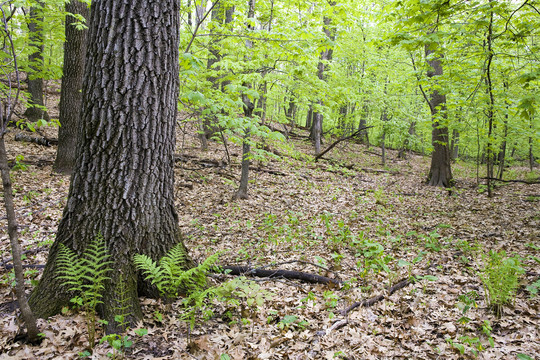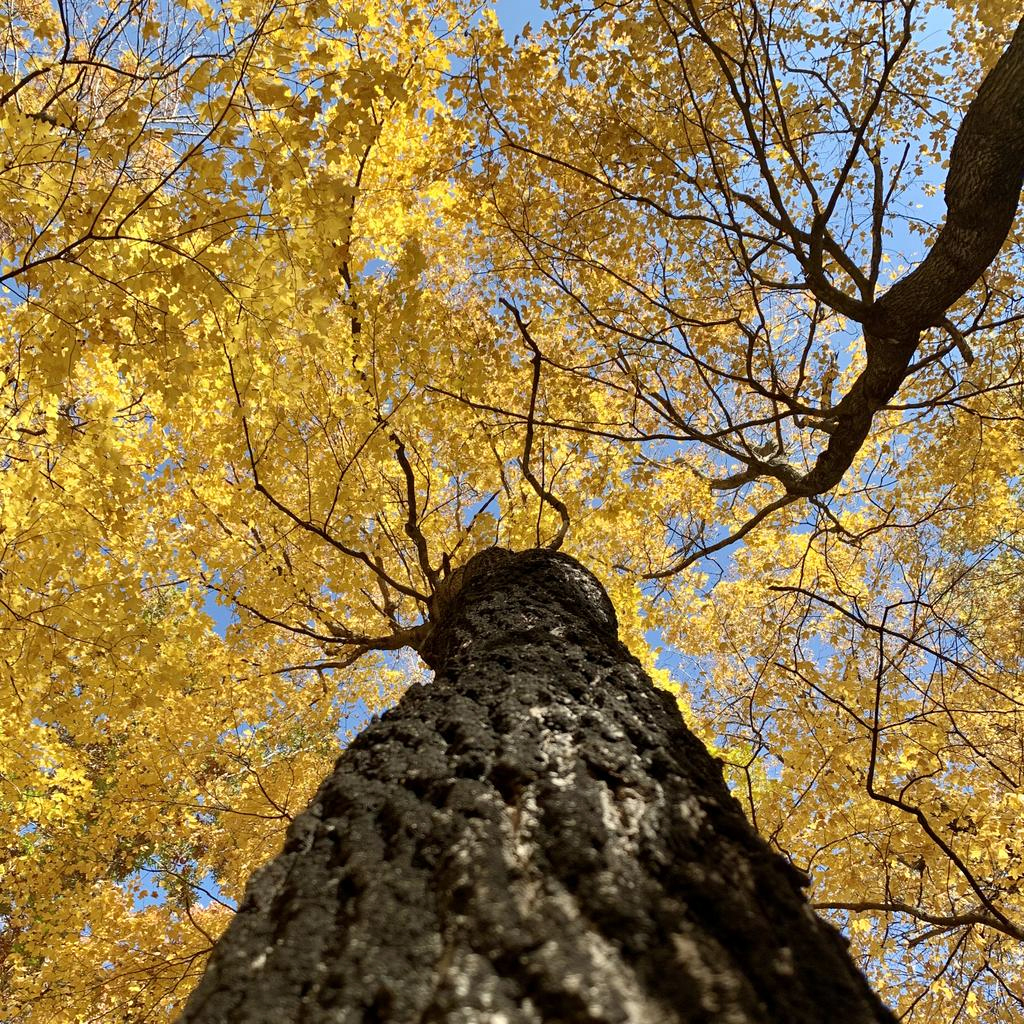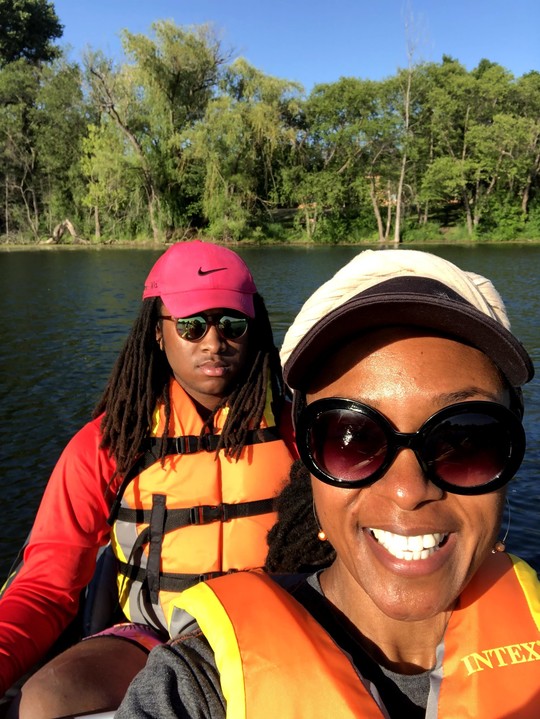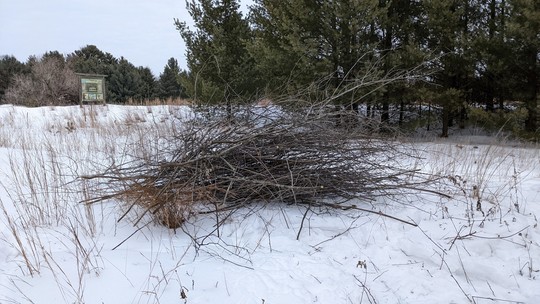Lost Forty
By Christopher Myers
An older silence lingers in this wood
than settled in surrounding vacant air,
when ax and blade had laid to rest the work
of each ring-tallied year.
Light seeps down in the shade like a resin,
spared dispensation for the crosscut snap
and fall that never cracked these acres’ air,
an error on a map.
Old-growth pine trees at Lost 40 SNA. Photo by Kelly Randall
Back to top

Site Highlight: Avon Hills Forest SNA
Kelly Randall, SNA Outreach Coordinator
|
 Wildflowers and ferns leaf-out under a canopy of native hardwoods at Avon Hills Forest SNA. Photo by ColdSnap Photography
I think of the spring and fall seasons like the quick-change artists of Minnesota’s forested landscapes. They seem to go by in the blink of an eye yet dazzle us with their striking colors and surprising beauty. The native hardwood forests blanketing the hilly terrain of Avon Hills Forest SNA have that dazzle, and I’d recommend a visit during these fast-paced “shoulder” seasons. In the fall maples, oaks, birch, and basswood delight with their warm oranges, reds, yellows, and browns. Spring wildflowers and birds surprise with their multitude of colors in a variety of shapes and sizes.
When visiting Avon Hills Forest SNA, you may notice it is part of a larger forested landscape. These connected complexes are a key component in preserving biological diversity and sustaining healthy habitats for an array of wildlife. The SNA is at the core of this forested complex and noted for outstanding biodiversity significance. Determined by DNR ecologists, the ranking measures ecological condition and statewide significance of intact native plant communities and wildlife diversity on natural landscapes. Only a small percentage of Minnesota landscapes meet these criteria.
Also of note is that of the 45 SNAs named in a 2009 study, Avon Hills Forest SNA ranked highest for species in greatest conservation need in Minnesota’s Wildlife Action Plan. Many of these species rely on this SNA's expansive, intact forest.
These special characteristics of the site and surrounding area enhance opportunities for wildlife watching, especially migrating songbirds in spring or fall. The site’s bird checklist notes 16 species of warblers and that over 120 bird species were surveyed in just one year. You’ll be sure to see or hear something interesting here.
 A large buckthorn surrounded by many small buckthorn seedlings at Avon Hills Forest SNA. Volunteers work to remove the seedlings in the vicinity. Photo by David Minor, MN DNR.
To maintain the quality of this site there is need to control invasive species, in particular buckthorn. During a buckthorn pull in fall 2019, SNA staff and volunteers found what looked like the source of a particular infestation one large buckthorn with hundreds of young seedlings packed densely around it. There are only a few of these infestations, and the hope is that targeted removals, such as that done in the fall of 2021, will over time keep this natural area natural.
 The bright colors of fall can be enjoyed while looking up the trunk of a maple tree at Avon Hills Forest SNA. Photo by Kelly Randall, MN DNR.
If you are looking for somewhere to see a diversity of plants and wildlife in an outstanding forest setting plan a visit to Avon Hills Forest SNA. Even without a visit, it is satisfying to know a rare jewel of Minnesota’s outstanding biodiversity will continue to be protected for generations to come.
Back to top

Say Hello to the New Volunteer Outreach Specialist!
Tieran Rosefield is the new Volunteer Outreach Specialist, a position created by the MN DNR for Conservation Corps Minnesota & Iowa Individual Placement members. Her work includes communicating with volunteers and staff within the SNA program and designing, coordinating, and leading SNA events. She joined the SNA crew in January 2022.

What is the best part about your job?
My favorite part of my job is designing and leading events. I get to delve into topics that I’m interested in, meet tons of new people, and share my love for the earth with others. I am very passionate about environmental education, and specifically in making it accessible, equitable, and enjoyable for everyone, so it feels good to have a part in that. Some events that I am planning or helping to plan include an intro to animal tracking, the Minneapolis-St. Paul City Nature Challenge, and a series of self-guided bioblitzes.
What is your favorite way to spend time outdoors?
Most of my free time is spent outdoors; I just feel better when I’m surrounded by nature. By far, my favorite outdoor activity is observing wildlife. Through my work and studies, I’ve picked up a lot of neat skills such as tracking, using trail cameras, and bird watching. There’s no better feeling than seeing a new species for the first time! I am also an avid hiker; I’m currently going through the MN State Park Hiking Club and I have a goal to visit all MN State Parks by the end of this year. I also enjoy biking, swimming, kayaking, camping, and photography.
What is your favorite native Minnesota plant or animal?
I am a lover of all things on this Earth and it is very difficult for me to choose, but I am partial to wildlife, and mammals in particular. If I had to name a few, I would say gray wolf, common raccoon, monarch, and great gray owl are at the top of my list. Raccoons are notable here, as I’ve worked with them extensively in the past and I love their curiosity and adaptability.
Back to top
Join the My MN Outdoor Adventure campaign
Do you like getting outdoors? If so, we’d love to see your pics! We’re especially looking for photos & stories from BIPOC folks who enjoy outdoor activities. #MyMNOutdoorAdventure aims to connect us to the great Minnesota outdoors—and to each other—through our shared stories. There are so many ways to get outside and enjoy nature. Show us how you do it: Share your outdoor story and photos and we’ll feature you on our website and social media channels!
 Back to the top
Notes from Site Stewards
Site stewards monitor, help with management tasks, and even lead events on SNAs across Minnesota. Their observations provide valuable information to the SNA Program. Here are some interesting notes from recent reports.
- Marsha Kurka has visited Boot Lake SNA several times this season. She is working hard to manage buckthorn populations on the site by cutting and piling it “high and dry.” We want to thank her for a wonderful job repairing a ‘No Snowmobiling’ sign.
- The stewards of Lost Valley Prairie SNA, Jim Smetana, Steve Poole, and Sara Brokaw are all eager to host monthly nature hikes for the spring and early summer. During their event in January, one of the attendees spotted a golden eagle!
- At a recent visit to Grey Cloud Dunes SNA, site steward Jeanne Caturia noticed an unleashed dog. Dogs are only allowed on select sites, but this site is not one of them. Remember to review all the rules before visiting an SNA.
- Scott Fluegel, one of our newest site stewards, visited Joseph A. Tauer Prairie SNA for the first time recently. He says that things are looking good, but he did notice some signs that need to be replaced.
 Buckthorn in a pile after being cut at Boot Lake SNA. Photo by Marsha Kurka.
Back to top

SNA Volunteer Stewardship Events on Pause
Due to a statewide policy requiring proof of COVID-19 vaccination for all DNR volunteers, the SNA Program has decided to put a pause on volunteer stewardship events for the foreseeable future. The burden of verifying this information, privacy concerns, and confusion it may cause are beyond the capacity of our Program to manage. For now, invasive species removal, seed collection, trash removal and similar events that need volunteers to work under the direction of DNR will not be planned or scheduled.
The SNA Program will however focus on interpretive and educational programming with events for visitors interested in learning more about SNAs, their special features, or the wildlife and plants found on them. We invite you to attend these upcoming events and keep an eye on the SNA event calendar for future opportunities.

|